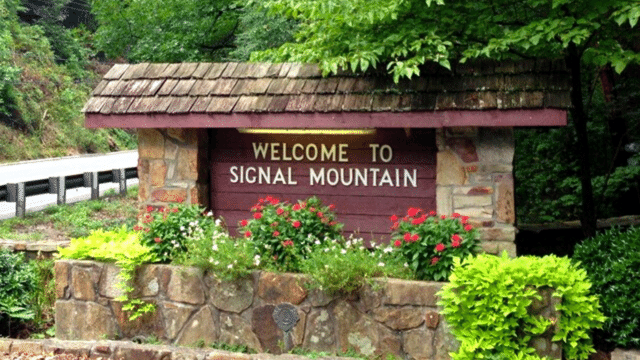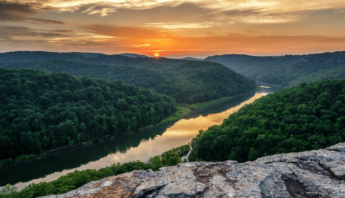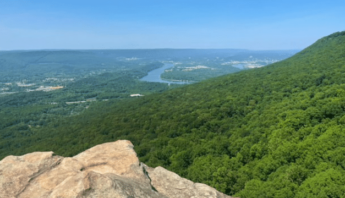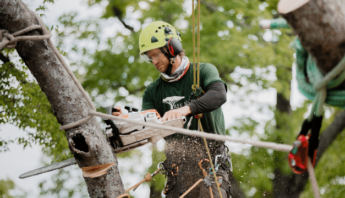The outdoors and our natural scenery is a big reason many people move to and/or stick around Chattanooga. Keeping our indigenous trees healthy is key to preserving the beauty that is this area.
We’re here to help with a series all about caring for the trees in various areas of the Tennessee Valley region starting with Signal Mountain.
We’ll walk through how to identify each of the common trees and the signs that something could be going wrong with trees on, or near, your property before they become a liability to you.
Hemlock Trees
Hemlock trees are one of the two trees du jour on Signal Mountain. We say this because they are more unique to the area than the more populous oak & maple trees, which we’ll get to in a bit, and they require more attention to keep healthy.
Hemlock love to grow near water on mountain ridges, hence their residency on Signal. Ever spotted a lot of salamanders near your home? Chances are you have a creek and hemlock trees nearby then. Hemlock provide a great deal of shade for the fish and salamanders that live in smaller bodies of water in elevation.
Identifying Hemlock
These can easily be mistaken as simple pine trees since their needles look very similar. Hemlock needles are flat though with two white stripes on the underside whereas pine needles are round. Both trees have branches that sprout directly out from the trunk.
Spotting Issues with Hemlock
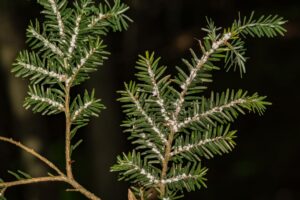 Keeping hemlock trees healthy is paramount for them to provide shade to the local aquatic wildlife. It’s time to call in our experienced arborists to treat the tree if you notice any of the following signs:
Keeping hemlock trees healthy is paramount for them to provide shade to the local aquatic wildlife. It’s time to call in our experienced arborists to treat the tree if you notice any of the following signs:
-
-
- Branches starting to thin out
- The canopy (i.e. top dense portion of tree) looking a little lackluster
- More needles in your yard than expected
-
In the fall through late spring seasons there is also a particularly high chance of infestation from a bug that creates white, cotton-like masses on the underside of the branches. If left untreated this can kill a hemlock and create a greater issue on your hands as the property owner as it starts to die.
Sad fact:
Most of the hemlock trees on Signal Mountain are affected by this infestation and require biannual treatments.
Ash Trees
The second most talked about tree on Signal is the ash tree. They boast a similar bark to hickory trees, but with a distinct limb arrangement making them easier to differentiate and spot among other trees in the region.
Identifying Ash Trees
Unlike hemlock that have branches coming straight out from the trunk, ash tree branches have what’s called an opposite arrangement meaning what grows on one side also grows in a mirror image on the other.
For instance, if there is a branch three feet in length on one side, a duplicate will be on the other side at the same length. This applies no matter how long the branch is as well.
Additionally ash trees are recognized by their compound leaves, one leaf with anywhere from five to nine leaflets coming from it.
Spotting and Treating Issues with Ash Trees
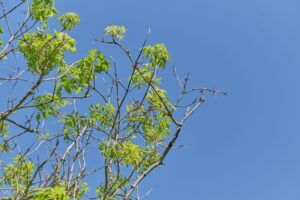 Ash trees are big boys at 90 feet tall with diameters that can be up to 60-inches. The key to spotting an issue with an ash is to look up. These trees die from the top down.
Ash trees are big boys at 90 feet tall with diameters that can be up to 60-inches. The key to spotting an issue with an ash is to look up. These trees die from the top down.
Walk a distance away and look toward the canopy of the trees around your property. If you notice the tips of branches dying, particularly at the top, and the bottom of the tree is healthy then your ash tree is calling out for help.
The most likely cause is, you guessed it, infestation by the invasive, yet pleasantly named due to its richly green exoskeleton, the emerald ash borer. These little beasts are the cause of any untreated ash trees whose collapse on a property could mean a call to us and your insurance company.
Best time to treat ash trees is during the warmer months of May through September.
Maple Trees
The remainder of the trees, which make up the majority of the greenery we see in Signal Mountain are oak trees or maple trees, both of which are densely populated throughout the ridge in multiple species.
As mentioned earlier, maple trees are among the most populous trees in the area. Like the oaks, there are multiple species though red, silver, sugar and box elder varieties are the four most predominant in our area.
Identifying Maple Trees
These are surely the most easily identifiable trees due to our friends to the north (i.e. Canadians) who have its leaf on their country’s flag. The simple, single leaf design that changes through the traditional fall colors as the weather cools later in the year.
Spotting Issues with Maple Trees
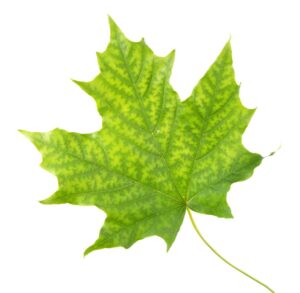
Maple leaf with chlorosis
A tell tale sign your maple tree needs some tending too is the presence of girdling roots, or roots that poke up largely above ground at the base of the tree. This adds additional pressure to the trunk and prevents water and nutrients from being absorbed all the way up, killing the tree over time.
A second sign of a problem is what’s known as chlorosis, a yellowing of leaves that should be green due to a lack of nutrients.
Oak Trees
Oaks in particular can be found throughout Old Town and on properties along the brow. Many of these trees had been planted nearly 100 or more years ago and have become quite prominent on the properties they inhabit.
Identifying Oak
These can easily be spotted by two main factors:
-
-
- They are the only tree with acorns.
- Their leaves are simple and singular in design. (Think about how a maple leaf is easy to identify based on their distinctive leaf shape; the same is true here.)
-
Oak trees come in many varieties but are primarily divided into two families, red and white, based on the leaf shape. White oaks have slow margins whereas red oaks have multiple points on their leaves.
Spotting Issues with Oak
There are two big issues with oak trees that can be identified quickly:
-
-
-
- Overextended branches. These are way too long due to a lack of pruning and tend to sag towards the end or make the trees canopy sag.
- Dead wood in the canopy. When looking up, do you see sections of clearly dead wood in any of the branches? Even if the rest of the tree seems fine, those dead sections are a red flag that your tree needs attention.
-
-
If you spot any of these issues with your trees, it’s time to schedule a consultation for one of our arborists to come check out the situation and create a customized plan to keep your property’s trees healthy and incident-free.


